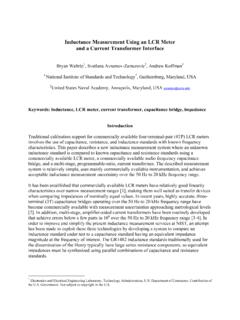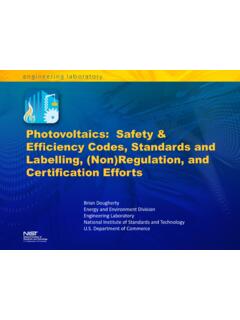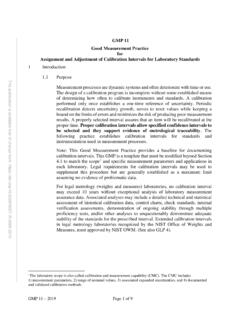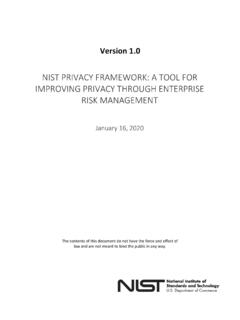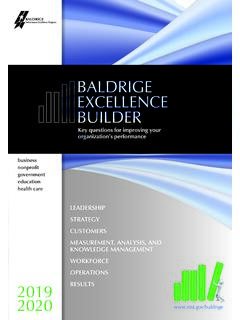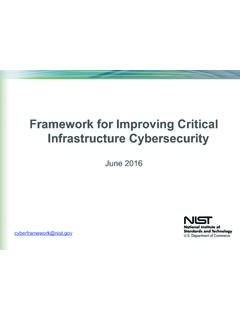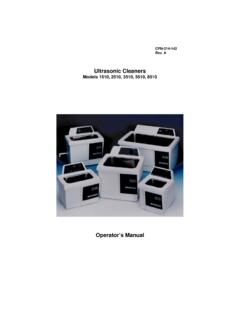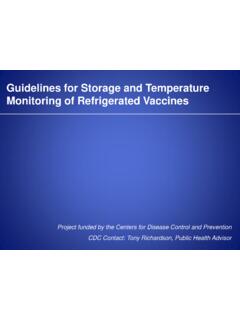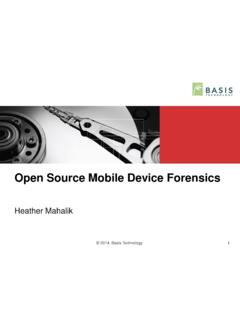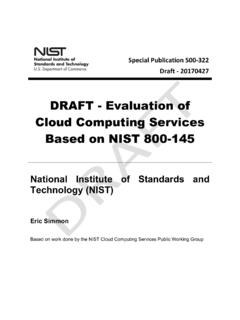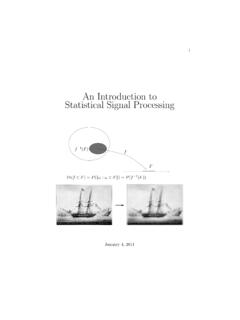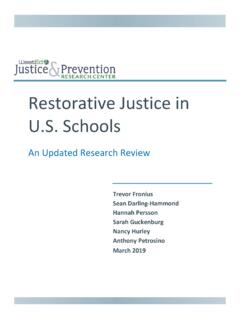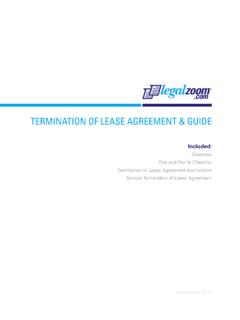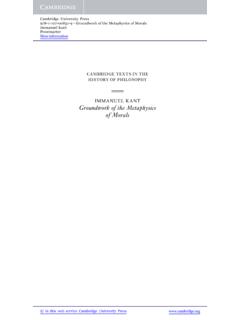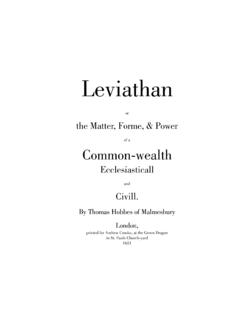Transcription of AI Risk Management Framework Concept Paper
1 AI Risk Management Framework Concept Paper 13 December 2021. NOTE TO REVIEWERS. This Artificial Intelligence Risk Management Framework (AI RMF) Concept Paper incorporates input from the Notice of Request for Information (RFI) released by the National Institute of Standards and Technology (NIST) on July 29, 20211, and discussions during the workshop, Kicking off NIST AI Risk Management Framework , held October 19-21, Feedback on this Paper will inform further development of this approach and the first draft of the AI RMF. for public comment. NIST intends to publish that initial draft for public comment in early 2022, as well as to hold additional workshops, with the goal of releasing the AI RMF in early 2023. NIST would appreciate feedback on whether the Concept proposed here is a constructive approach for the AI RMF. While additional details will be provided in the more extensive discussion drafts of the Framework , NIST welcomes suggestions now about this approach as well as details and specific topics reviewers would like to see included in the upcoming first draft of the AI RMF.
2 Specifically, NIST requests input on the following questions: Is the approach described in this Concept Paper generally on the right track for the eventual AI. RMF? Are the scope and audience (users) of the AI RMF described appropriately? Are AI risks framed appropriately? Will the structure consisting of Core (with functions, categories, and subcategories), Profiles, and Tiers enable users to appropriately manage AI risks? Will the proposed functions enable users to appropriately manage AI risks? What, if anything, is missing? Please send feedback on this Paper to by January 25, 2022. 1. 2 1. 1 AI Risk Management Framework Concept Paper 2 1 Overview 3 This Concept Paper describes the fundamental approach proposed for the National Institute of Standards and 4 Technology (NIST) Artificial Intelligence Risk Management Framework (AI RMF or Framework ). The AI RMF is 5 intended for voluntary use and to address risks in the design, development, use, and evaluation of AI products, 6 services, and systems.
3 7 AI technologies extend algorithmic methods and automation into new domains and roles, including advising 8 people and taking actions in high-stakes decisions. The goal of managing the risks associated with the use of AI. 9 technologies for such tasks as recommendation, diagnosis, pattern recognition, and automated planning and 10 decision-making frames opportunities for developing and using AI in ways that will increase their 11 trustworthiness and advance their usefulness, while addressing potential harms. 12 AI risk Management follows similar processes as other disciplines. Nevertheless, managing AI risks presents 13 unique challenges. An example is the evaluation of effects from AI systems that are characterized as being 14 long-term, low probability, systemic, and high impact. Tackling scenarios that can represent costly outcomes or 15 catastrophic risks to society should consider: an emphasis on managing the aggregate risks from low 16 probability, high consequence effects of AI systems, and the need to ensure the alignment of ever more 17 powerful advanced AI systems.
4 This proposed AI RMF is an initial attempt to describe how AI risks differ from 18 other domains, and to offer directions leveraging a multi-stakeholder approach for creating and 19 maintaining actionable guidance that is broadly adoptable. 20 AI risk Management entails challenges that reflect both the breadth of AI use cases and the quickly evolving 21 nature of the field. The AI ecosystem is home to a multitude of diverse stakeholders, including developers, 22 users, deployers, and evaluators. For organizations, identifying, assessing, prioritizing, responding to, and 23 communicating risks across business and social relationships at scale can be a difficult task. These challenges 24 are amplified by the heterogeneity of AI risks, whether in degree or in kind, which potentially include harmful 25 bias, threats to safety, privacy, and consumer protection, among others. 26 A voluntary consensus-driven Framework can help create and safeguard trust at the heart of AI-driven systems 27 and business models and permit the flexibility for innovation, allowing the Framework to develop along with 28 the technology.
5 29 NIST's work on the Framework is consistent with its broader AI efforts as called for by the National AI. 30 Initiative Act of 2020, the National Security Commission on Artificial Intelligence recommendations, and 31 the Plan for Federal Engagement in AI Standards and Related Tools for NIST to collaborate with the private 32 and public sectors to develop the AI RMF. 33 2 Scope and Audience 34 The NIST AI RMF is intended to serve as a blueprint for mapping, measuring, and managing risks related to AI. 35 systems across a wide spectrum of types, applications, and maturity. This resource will be organized and 36 written in such a way that it can be understood and used by the greatest number of individuals and 37 organizations, regardless of sector or level of familiarity with a specific type of technology. Ultimately, it will be 38 offered in multiple formats, including interactive versions, to provide maximum flexibility by users. 39 The intended primary audiences are: 40 (1) people who are responsible for designing or developing AI systems.
6 41 (2) people who are responsible for using or deploying AI systems; and 42 (3) people who are responsible for evaluating or governing of AI systems. 2. 1 A fourth audience who will serve as a key motivating factor in this guidance is 2 (4) people who experience potential harm or inequities affected by areas of risk that are newly 3 introduced or amplified by AI systems. 4 All stakeholders should be involved in the risk Management process. Stakeholders may include the 5 mission/task champion (leadership), program Management , system engineer, AI developer, requirements 6 representative, test and evaluation personnel, end user, and affected communities, depending on the 7 application. 8 3 Framing Risk 9 Within the context of the AI RMF, risk refers to the composite measure of an event's probability of occurring 10 and the consequences of the corresponding events. While some interpretations of consequence focus 11 exclusively on negative impacts (what is the likelihood that something bad will happen?)
7 , NIST intends to use a 12 broader definition that offers a more comprehensive view of potential influences, including those that are 13 positive, resonating with the goals of developing and applying AI technologies to achieve positive outcomes. If 14 handled appropriately, AI technologies hold great potential to uplift and empower people and to lead to new 15 services, support, and efficiencies for people and society. Identifying and minimizing potential costs associated 16 with AI technologies will advance those possibilities. 17 AI risk Management is as much about offering a path to minimize anticipated negative impacts of AI systems, 18 such as threats to civil liberties and rights, as it is about identifying opportunities to maximize positive impacts. 19 The AI RMF endeavors to lay the groundwork for a common understanding of roles and responsibilities across 20 the AI lifecycle. It is agnostic as to whether duties are dispersed and governed throughout an organization or 21 assumed by an individual without any organizational affiliation.
8 By focusing on measurable criteria that 22 indicate AI system trustworthiness in meaningful, actionable, and testable ways, this Framework Concept Paper 23 lays out the components of an effective AI risk Management program. The Framework is designed to be readily 24 useful to and usable by those with varied roles and responsibilities throughout the AI lifecycle. 25 4 Attributes of AI RMF. 26 NIST has developed a set of attributes based on public feedback from a recent request for information and 27 workshop. NIST encourages comments as to whether the Framework envisioned in this Concept Paper , as well 28 as all future documents released during the initial development of the AI RMF, successfully meets such 29 expectations. The following constitutes NIST's list of Framework attributes: 30 1. Be consensus-driven and developed and regularly updated through an open, transparent process. All 31 stakeholders should have the opportunity to contribute to and comment on the AI RMF development. 32 2.
9 Be clear. Use plain language that is understandable by a broad audience, including senior executives, 33 government officials, NGO leadership, and, more broadly, those who are not AI professionals, while 34 still of sufficient technical depth to be useful to practitioners. The AI RMF should allow for 35 communication of AI risks across an organization, with customers, and the public at large. 36 3. Provide common language and understanding to manage AI risks. The AI RMF should provide 37 taxonomy, terminology, definitions, metrics, and characterizations for aspects of AI risk that are 38 common and relevant across sectors. 39 4. Be easily usable. Enable organizations to manage AI risk through desired actions and outcomes. Be 40 readily adaptable as part of an organization's broader risk Management strategy and processes. 41 5. Be appropriate for both technology agnostic (horizontal) as well as context-specific (vertical) use cases 42 to be useful to a wide range of perspectives, sectors, and technology domains.
10 3. 1 6. Be risk-based, outcome-focused, cost-effective, voluntary, and non-prescriptive. It should provide a 2 catalog of outcomes and approaches to be used voluntarily, rather than a set of one-size-fits-all 3 requirements. 4 7. Be consistent or aligned with other approaches to managing AI risks. The AI RMF should, when 5 possible, take advantage of and foster greater awareness of existing standards, guidelines, best 6 practices, methodologies, and tools for managing AI risks as well as illustrate the need for additional, 7 improved resources. It should be law- and regulation-agnostic to support organizations' abilities to 8 operate under applicable domestic and international legal or regulatory regimes. 9 8. Be a living document. The AI RMF should be capable of being readily updated as technology, 10 understanding, and approaches to AI trustworthiness and uses of AI change and as stakeholders learn 11 from implementing AI risk Management generally and this Framework , in particular. 12 5 AI RMF Structure 13 The proposed structure for the AI RMF is composed of three components: 1) Core, 2) Profiles, and 3).
